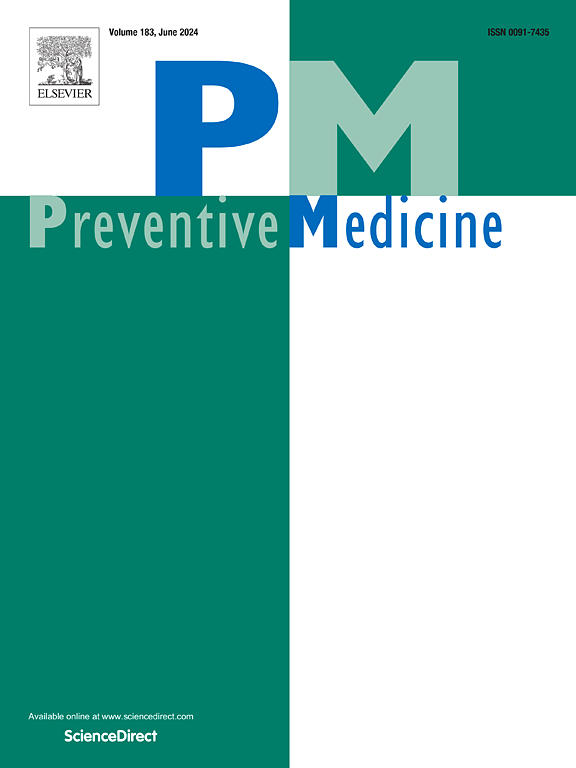长期骑自行车、游泳和网球的强度和量:与美国老年男性死亡风险的关系
IF 3.2
2区 医学
Q1 MEDICINE, GENERAL & INTERNAL
引用次数: 0
摘要
目的:研究美国老年男性个体体育活动强度和运动量与死亡风险的关系。方法:我们前瞻性随访了10218名健康专业人员随访研究(2012-2022)的男性,他们在基线时无糖尿病、心血管疾病或癌症。骑车、游泳和网球的强度采用两年一次的问卷调查进行评估,并将其分为低强度、中/高强度两组。累积平均体力活动量按砖块分类:低体积、中/高体积。我们使用多变量调整的Cox比例风险回归模型来评估风险比(hr)和95% % CI,研究了身体活动强度和体积与死亡率的联合关联。结果:随访超过89,168人年(基线时平均[SD]年龄,73.8[6.9]岁[范围,65-102 岁]),记录了2303例死亡。与不参加这些活动相比,骑自行车(HR: 0.83[95 % CI: 0.73, 0.94])、游泳(HR: 0.81[95 % CI: 0.63, 1.03])和网球(HR: 0.83[95 % CI: 0.65, 1.05])的中/高强度运动分别与降低死亡风险呈正相关。此外,与非参与者相比,骑自行车(中/高强度和低容量:HR 0.89[95 % CI 0.76, 1.05])、游泳(低强度和低容量:HR 0.77[95 % CI 0.57, 1.06])和网球(低强度和中/高容量:HR 0.49[95 % CI 0.23, 1.01])的特定强度和容量水平与降低死亡风险呈显著相关。结论:体力活动强度和运动量都与骑自行车、打网球和游泳的死亡风险有关,强调了在未来研究中检查这两个因素的必要性。本文章由计算机程序翻译,如有差异,请以英文原文为准。
Long-term intensity and volume of biking, swimming, and tennis: Associations with mortality risk in US older men
Objectives
To study the association of intensity and volume of individual physical activities with mortality risk among US older males.
Methods
We prospectively followed 10,218 men in Health Professionals Follow-up Study (2012−2022) who were free of diabetes, cardiovascular disease or cancer at baseline. Intensity of biking, swimming and tennis was assessed using biennial questionnaires and categorized into two intensity groups: low intensity, medium/high intensity. Cumulative averaged physical activity volume was classified based on tertiles: low volume, medium/high volume. We examined joint associations of physical activity intensity and volume with mortality using multivariable-adjusted Cox proportional hazards regression models to estimate hazard ratios (HRs) and 95 % CI.
Results
During 89,168 person-years of follow-up (mean [SD] age at baseline, 73.8 [6.9] years [range, 65–102 years]), 2303 deaths were documented. Medium/high intensity performed at medium/high volume was suggestively associated with reduced mortality risk for biking (HR: 0.83 [95 % CI: 0.73, 0.94]), swimming (HR: 0.81 [95 % CI: 0.63, 1.03]), and tennis (HR: 0.83 [95 % CI: 0.65, 1.05]), compared with non-participation in these activities, respectively. Further, specific levels of intensity and volume in biking (medium/high intensity and low volume: HR 0.89 [95 % CI: 0.76, 1.05]), swimming (low intensity and low volume: HR 0.77 [95 % CI: 0.57, 1.06]), and tennis (low intensity and medium/high volume: HR 0.49 [95 % CI: 0.23, 1.01]) were suggestively associated with reduced mortality risk compared with non-participants.
Conclusions
Both physical activity intensity and volume inform on mortality risk for biking, tennis and swimming, highlighting the necessity of examining both factors in future research.
求助全文
通过发布文献求助,成功后即可免费获取论文全文。
去求助
来源期刊

Preventive medicine
医学-公共卫生、环境卫生与职业卫生
CiteScore
7.70
自引率
3.90%
发文量
0
审稿时长
42 days
期刊介绍:
Founded in 1972 by Ernst Wynder, Preventive Medicine is an international scholarly journal that provides prompt publication of original articles on the science and practice of disease prevention, health promotion, and public health policymaking. Preventive Medicine aims to reward innovation. It will favor insightful observational studies, thoughtful explorations of health data, unsuspected new angles for existing hypotheses, robust randomized controlled trials, and impartial systematic reviews. Preventive Medicine''s ultimate goal is to publish research that will have an impact on the work of practitioners of disease prevention and health promotion, as well as of related disciplines.
 求助内容:
求助内容: 应助结果提醒方式:
应助结果提醒方式:


